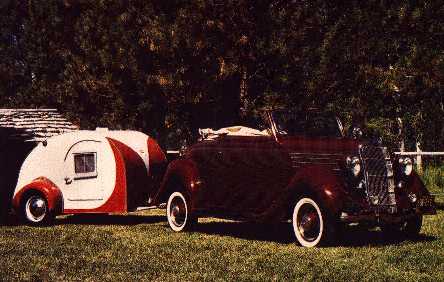|
|
|
TEARDROP TRAILER HERITAGE
|
Prev Next
Home Slide 4 of 5 December 16, 1998 |
SECTION THREE:
Then in October of 1945, C.W."Bill" Worman and Andy Anderson formed Kit Manufacturing Co. in an abandoned fruit stand on Telegraph Road in Norwalk, California to produce "Kit Kamper" Tear Drop Trailers. They had no orders yet, but their plan was to produce the cute little aluminum-clad trailers in knocked-down form to be assembled by the purchaser.
It was at this time that a third party, Dan Pocapalia, became interested in the project. Worman and Pocapalia had been friends and co-workers at Vultee Aircraft in Norwalk during the war.
Dan Pocapalia purchased Andy Anderson's half-interest in Kit Manufacturing Co. for $800. The two of them now had a building a dream and 60 Fulton trailer hitches.
Worman and Pocapalia soon learned that what the public wanted was not a kit, but a completed trailer. They made the decision to produce the the trailers in completed form. Pocapalia took responsibility for redesigning the trailer to make it easier to assemble with less waste of raw materials. Worman took on the job of material procurement.
Materials after the war had to be obtained from surplus markets. The chassis was made of 2"x1" steel U channel, when it could be found, and from 1-1/2" round tube steel tube otherwise. Wheels were from Jeeps salvaged from sunken ships. Many had bullet holes in them which were welded up. Exterior skin was of .032" thick 24S-T aircraft grade aluminum.
The first public showing was at Gilmore Stadium in L.A. in February of 1946. They took 12 completed units to the show and booked 500 firm orders at a dealer cost of $500. Some dealers paid in advance. many offered to pay a bonus to get early delivery. The 4'x8' "Kit Kamper" TearDrop Trailer was destined to win the hearts of Americans... and a place in history.
At midyear 1946, Pocapalia and Worman decided to upgrade the model by adding a second door and fiberglass (a new technology) fenders as well as a 10 gallon water tank, chrome yoke and other cosmetics, including a butane stove with a Manchester butane bottle.
They ended up with two models, the"Standard" and a "Super Deluxe"
with the second door (port side), fenders and a dealer cost of $595.

Sales were going crazy. Over 1,000 units were backlogged and by July, Kit was operating two shifts and turning out 40 trailers a day. A total of 4,500 Kit Kampers were produced in 1946 and 1947.
Success demanded change and in January of 1948 Kit went into production of a more conventional 8'x14' "coach" with demand far exceeding production capability. The "Kit Kamper" teardrop assembly line was ended!